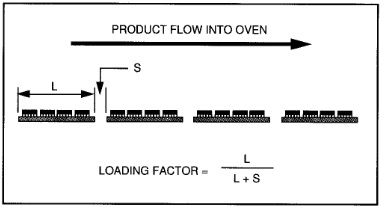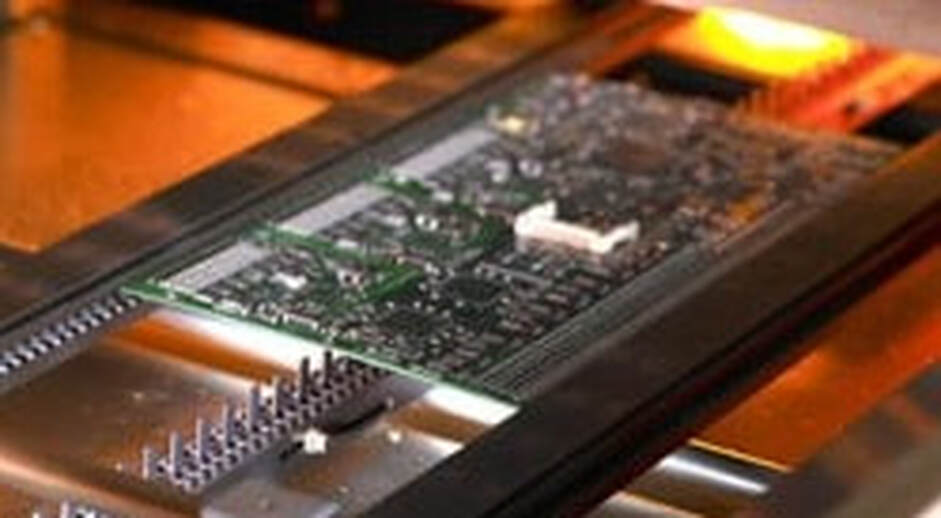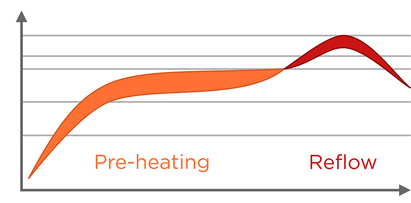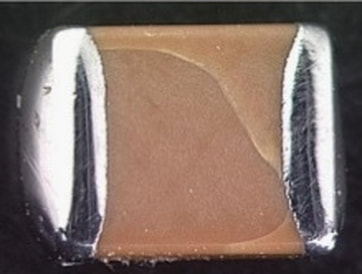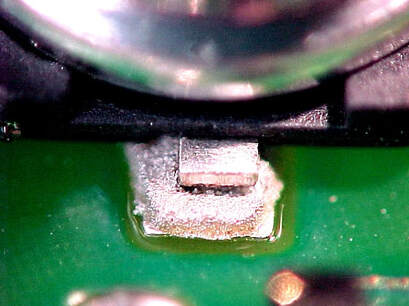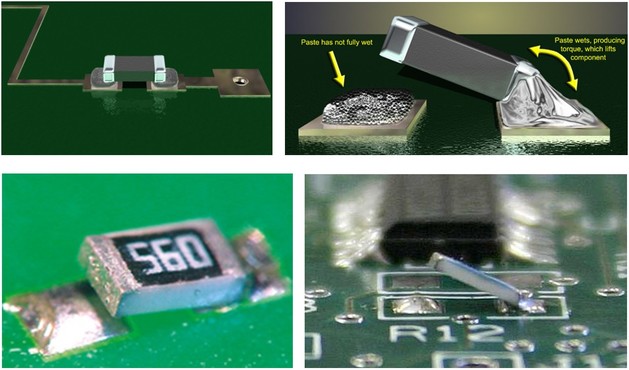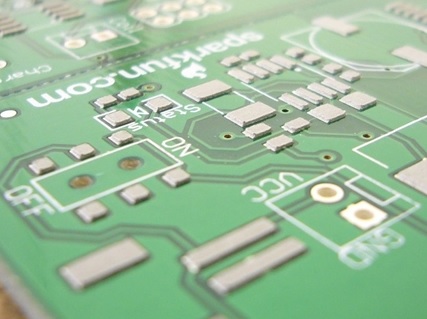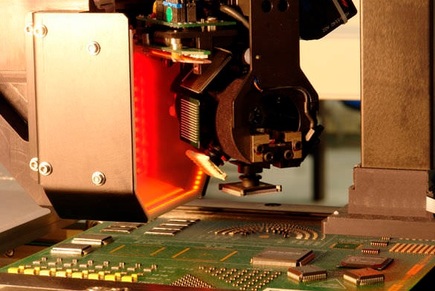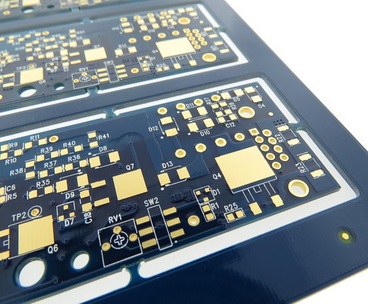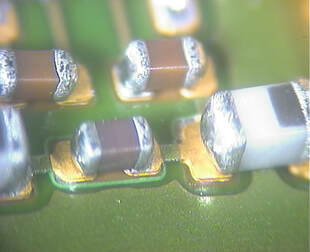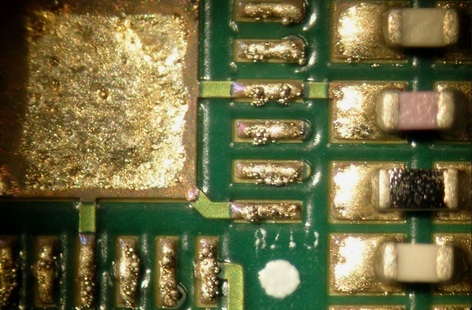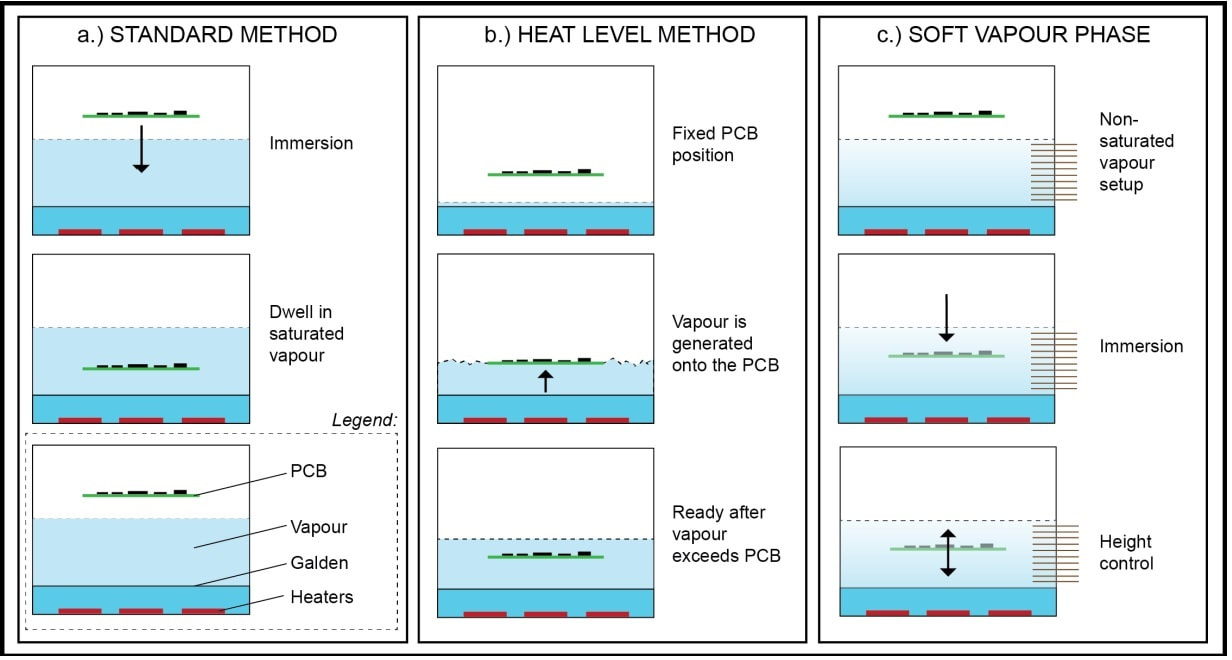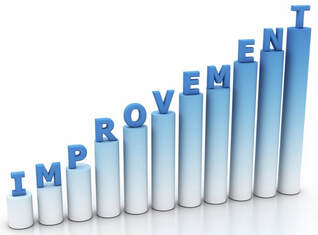|
|
Reflow soldering is the most widely used method of attaching surface mount components to printed circuit boards (PCBs). The aim of the process is to form acceptable solder joints by first pre-heating the components/PCB/solder paste and then melting the solder without causing damage by overheating.
The key aspects that lead to an effective reflow soldering process are as follows:-
|
|
|
Suitable Machine
There are various types of reflow soldering machine available depending on the required line speed and design/material of the PCB assemblies to be processed. The selected oven needs to be of a suitable size to handle the production rate of the pick and place equipment.
The line speed can be calculated as shown below:-
Line speed (minimum) = Boards per minute x Length per board
Load Factor (space between boards)
It is important to consider the repeatability of the process and so the ‘Load Factor’ is usually specified by the machine manufacturer, calculation shown below:-
The line speed can be calculated as shown below:-
Line speed (minimum) = Boards per minute x Length per board
Load Factor (space between boards)
It is important to consider the repeatability of the process and so the ‘Load Factor’ is usually specified by the machine manufacturer, calculation shown below:-
To be able to select the correct size reflow oven the process speed (defined below) must be greater than the minimum calculated line speed.
Process speed = Oven chamber heated length
Process dwell time
Below is an example of calculation to establish the correct oven size:-
An SMT assembler wants to produce 8-inch boards at a rate of 180 per hour. The solder paste manufacturer recommends a 4 minute, three step profile. How long an oven do I need to process boards at this throughput?
Boards per minute = 3 (180/hour)
Length per board = 8 inches
Load Factor = 0.8 (2-inch space between boards)
Process Dwell Time = 4 minutes
Calculate Line Speed: (3 boards/min) x (8 inches/board)
0.8
Line speed = 30 inches/minute
Therefore, the reflow oven must have a process speed of at least 30 inches per minute.
Determine oven chamber heated length with process speed equation:
30 in/min = Oven chamber heated length
4 minutes
Oven heated length = 120 inches (10 feet)
Note that the overall length of the oven will exceed 10 feet including the cooling section and conveyor loading sections. The calculation is for HEATED LENGTH – NOT OVERALL OVEN LENGTH.
The design of the PCB assembly will influence the machine selection and what options are added to the specification. Machine options that are usually available are as follows:-
1. Conveyor type – It is possible to select a machine with mesh conveyor but generally edge conveyors are specified to enable the oven to work in-line and be able to process double sided assemblies. In addition to the edge conveyor a centre-board-support is usually included to stop the PCB from sagging during the reflow process – see below. When processing double sided assemblies using the edge conveyor system care must be taken to not disturb components on the underside.
1. Conveyor type – It is possible to select a machine with mesh conveyor but generally edge conveyors are specified to enable the oven to work in-line and be able to process double sided assemblies. In addition to the edge conveyor a centre-board-support is usually included to stop the PCB from sagging during the reflow process – see below. When processing double sided assemblies using the edge conveyor system care must be taken to not disturb components on the underside.
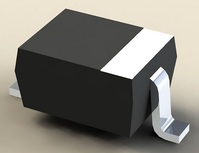
2. Closed loop control for speed of convection fans - There are certain surface mount packages such as the SOD323 (see insert) which have a small contact area to mass ratio which are susceptible to be disturbed during the reflow process. Closed loop speed control of the convention fans is a recommended option for assemblies using such parts.
3. Automatic control of conveyor and centre-board-support widths – Some machines have manual width adjustment but if there are many different assemblies to be processed with varying PCB widths then this option is recommended to maintain a consistent process.
Acceptable Reflow Profile
In order to create an acceptable reflow profile each assembly needs to be considered separately as there are many different aspects that can affect how the reflow oven is programmed. Factors such as:-
- Type of solder paste
- PCB material
- PCB thickness
- Number of layers
- Amount of copper within the PCB
- Number of surface mount components
- Type of surface mount components
In order to create a reflow profile thermocouples are connected to a sample assembly (usually with high temperature solder) in a number of locations to measure the range of temperatures across the PCB. It is recommended to have at least one thermocouple located on a pad towards the edge of the PCB and one thermocouple located on a pad towards the middle of the PCB. Ideally more thermocouples should be used to measure the full range of temperatures across the PCB – known as ‘Delta T’.
Within a typical reflow soldering profile there are usually four stages – Preheat, soak, reflow and cooling. The main aim being to transfer enough heat into the assembly to melt the solder and form the solder joints without causing any damage to components or PCB.
Preheat – During this phase the components, PCB and solder are all heated to a specified soak or dwell temperature being careful not to heat too quickly (usually no more than 2ºC/second - check solder paste datasheet). Heating too quickly can cause defects such as components to crack and the solder paste to splatter causing solder balls during reflow.
Soak – The purpose of this phase is to ensure all components are up to the required temperature before entering the reflow stage. Soak usually lasts for between 60 and 120 seconds depending on the 'mass differential' of the assembly and types of components present. The more efficient the heat transfer during the soak phase the less time is needed.
Care needs to be taken not to have an excessive soak temperature or time as this may result in the flux becoming exhausted. Signs that the flux has become exhausted are 'Graping' and 'Head-in-pillow'.
Reflow – This is the stage where the temperature within the reflow oven is increased above the melting point of the solder paste causing it to form a liquid. The time the solder is held above its melting point (time above liquidus) is important to ensure correct ‘wetting’ occurs between components and PCB. The time is usually 30 to 60 seconds and shouldn’t be exceeded to avoid the formation of brittle solder joints. It is important to control the peak temperature during the reflow phase as some components can fail if exposed to excessive heat.
While it is important not to apply too much heat during reflow it is equally important for the reflow profile to be hot enough. When processing assemblies with BGA's fitted it is important to apply enough heat to melt/reflow the balls of the BGA to ensure a good solder joint. This is know as a double drop and can be seen in the video below:-
|
|
|
If the reflow profile has insufficient heat applied during the reflow stage there will be solder joints seen similar to the images below:-
A common soldering defect after reflow is the formation of mid-chip solder balls/beads as can be seen below. The solution to this defect is to modify the stencil design - more details can be seen here.
For more detail on reflow soldering defects and possible solutions,
see our 'Surface Mount Troubleshooting Guide'.
see our 'Surface Mount Troubleshooting Guide'.
When using lead-free alloys, it is important to know which alloy is being used (i.e SAC305/SAC387, Low-Temperature) as will have an impact on the reflow temperatures needed.
The use of nitrogen during the reflow process should be considered due to the trend of moving away from solder paste that contains strong fluxes. The issue is really not the ability to reflow in nitrogen, but rather the ability to reflow in the absence of oxygen. Heating solder in the presence of oxygen will create oxides, which are generally non-solderable surfaces.
Cooling – This is simply the stage during which the assembly is cooled but it is important to not cool the assembly too rapidly - usually the recommended rate of cooling should not exceed 3ºC/second.
PCB/Component Footprint Design
There are a number of aspects of PCB design that have an influence on how well an assembly will reflow. An example being the size of tracks connecting to a component footprint – if the track connecting to one side of a component footprint is larger than the other this can lead to a thermal imbalance causing the part to ‘tombstone’ as can be seen below:-
Another example is ‘copper balancing’ – many PCB designs use large copper areas and if the pcb is put into a panel to aid the manufacturing process it can lead to an imbalance in copper. This can cause the panel to warp during reflow and so the recommended solution is to add ‘copper balancing’ to the waste areas of the panel as can be seen below:-
Carefully printed PCB using well designed stencil
The earlier process steps within surface mount assembly are critical to an effective reflow soldering process. The solder paste printing process is key to ensure a consistent deposit of solder paste onto the PCB. Any fault at this stage will lead to undesired results and so complete control of this process along with effective stencil design is needed.
Repeatable placement of surface mount components
The placement of surface mount components must be repeatable and so a reliable, well maintained pick and place machine is necessary. If component packages are not taught in the correct way it can cause the machines vision system to not see each part in the same way and so variation in placement will be observed. This will lead to inconsistent results after reflow soldering process.
Component placement programs can be created using the pick and place machines but this process isn't as accurate as taking the centroid information directly from the PCB Gerber data. Quite often this centroid data is exported from the PCB design software but sometime is not available and so the service to generate the centroid file from Gerber data is offered by Surface Mount Process.
All components placement machines will have a ‘Placement Accuracy’ specified such as:-
35um (QFPs) to 60um (chips) @ 3 sigma
It is also important for the correct nozzle to be selected for the component type to be placed – a range of different component placement nozzles can be seen below:-
Good quality PCB, components and solder paste
The quality of all items used during the process must be high because anything of a poor quality will lead to undesirable results. Depending on the manufacturing process of the PCB’s and the way in which they have been stored the finish of the PCB’s can lead to poor solderabilty during the reflow soldering process. Below is an example of what can be seen when the surface finish on a PCB is poor leading to a defect known as ‘Black Pad’:-
In a similar way the quality of the surface mount component leads can be poor depending on the manufacturing process and method of storage.
The quality of the solder paste is greatly affected by the storage and handling. Poor quality solder paste if used is likely to give results as can be seen below:-
Vapour phase soldering
This process has an extremely high heat transfer coefficient and is therefore well suited for components with a high thermal mass. In addition, it is easy to control and uniform. Which means that fine-pitch structures as well as sensitive and expensive components can also be reliably soldered. LEDs, for example, are quite susceptible to temperature-related damage - the risk of this is significantly reduced with vapour phase soldering. Inline vapour phase soldering systems for series production are available for industry. They are significantly more energy efficient than the full convection systems mentioned. For the prototyping area, there are compact vapour phase soldering systems that represent an interesting alternative to the equally flexible and compact hot air stations.
Inside the system there is a liquid medium. Most commonly used is perfluoropolyether, a fluorinated hydrocarbon, also known by the brand name Galden. This medium boils at a certain temperature. There are different types of Galden to choose from. The commonly used Galden LS230 is boiling at exactly 230°C, that corresponds to 446°F. This boiling temperature is limiting the maximum temperature that can be reached within the process.
This is very important to know when setting the temperature profile for the process. This soldering profile determines at which time which temperature should prevail. It also must consider the needs of the components and the soldering paste used. Both temperature-sensitive components, such as LEDs, and high thermal masses must be considered when setting up the temperature course.
This is very important to know when setting the temperature profile for the process. This soldering profile determines at which time which temperature should prevail. It also must consider the needs of the components and the soldering paste used. Both temperature-sensitive components, such as LEDs, and high thermal masses must be considered when setting up the temperature course.
After the board has been prepared with solder paste and the components have been attached to the appropriate contacts, the board is placed in the vapour phase soldering machine. The soldering process starts by heating the system and following the predetermined temperature course.
When the Galden is boiling, a vapour arises which is heavier than air. The circuit board is then exposed to this vapour. The medium condenses at the surface of the assembly. The vapour is displacing nearly all the oxygen, this prevents oxidation on the assembly. While the Galden is condensing, it transfers the thermic energy evenly into the assembly. This heats up the PCB, the components and the solder paste that is applied between them. The solder paste will melt as soon as the PCB reaches the appropriate temperature, which depends on the solder paste that is used. Typically, this happens around 180°C, that corresponds to 356°F. When the temperature decreases there is still a lot of vapour in the process chamber. It is important to remain the system closed, until the vapour condensates and the Galden is liquid again. This also helps to reduce costs because Galden is quite expensive. The longer a system can cool down, the more Galden condensates and can be reused in the following soldering cycles.
A powerful cooling system is key to reduce the waiting period between several soldering cycles. As soon as the temperature drops significantly the solder paste will solidify and the components are soldered on the circuit board.
When the Galden is boiling, a vapour arises which is heavier than air. The circuit board is then exposed to this vapour. The medium condenses at the surface of the assembly. The vapour is displacing nearly all the oxygen, this prevents oxidation on the assembly. While the Galden is condensing, it transfers the thermic energy evenly into the assembly. This heats up the PCB, the components and the solder paste that is applied between them. The solder paste will melt as soon as the PCB reaches the appropriate temperature, which depends on the solder paste that is used. Typically, this happens around 180°C, that corresponds to 356°F. When the temperature decreases there is still a lot of vapour in the process chamber. It is important to remain the system closed, until the vapour condensates and the Galden is liquid again. This also helps to reduce costs because Galden is quite expensive. The longer a system can cool down, the more Galden condensates and can be reused in the following soldering cycles.
A powerful cooling system is key to reduce the waiting period between several soldering cycles. As soon as the temperature drops significantly the solder paste will solidify and the components are soldered on the circuit board.
|
|
|
Conclusion
The ideal reflow solder profile for each assembly does exist. The reflow soldering process can be time consuming to setup but is essential to ensure all components are fully soldered without being damaged. It is even more important when profiling a lead-free assembly due to the acceptable temperature range being reduced to that of a tin-lead assembly. Using a carefully designed profile will result in a repeatable process which will consistently deliver the required results - It is worth the extra time and effort.
An Increase in Efficiency and Productivity
It’s a shocking statistic to read that within the electronics industry many surface mount operations, particularly within the sub-contract manufacturing sector, run as low as 20% efficient.
There are many reasons that contribute to this figure but it fundamentally means that only 20% of the capital investment is being utilized. Financially speaking, this will lead to a higher cost of ownership and a slower return on investment. For the customer, it can cause longer lead times for their product and therefore the business will not be as competitive in the market place.
With production efficiencies at this level there will be many knock-on effects that will have an impact on the business such as larger batch sizes, more parts in stock, more assemblies in WIP (work in progress) and slower reaction times to customer change requirements.
With all this in mind there is a strong incentive to improve efficiency while maintaining quality.
There are many reasons that contribute to this figure but it fundamentally means that only 20% of the capital investment is being utilized. Financially speaking, this will lead to a higher cost of ownership and a slower return on investment. For the customer, it can cause longer lead times for their product and therefore the business will not be as competitive in the market place.
With production efficiencies at this level there will be many knock-on effects that will have an impact on the business such as larger batch sizes, more parts in stock, more assemblies in WIP (work in progress) and slower reaction times to customer change requirements.
With all this in mind there is a strong incentive to improve efficiency while maintaining quality.
We also offer a general consultation service to discuss any particular challenge you may be facing.
If this of interest please send a message using the Contact Page
If this of interest please send a message using the Contact Page

